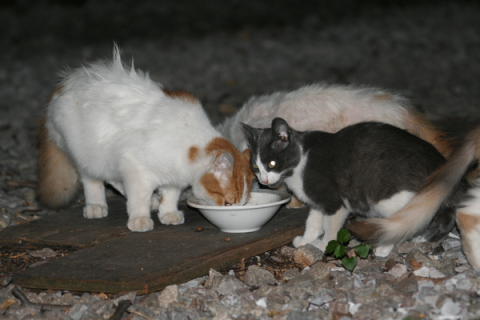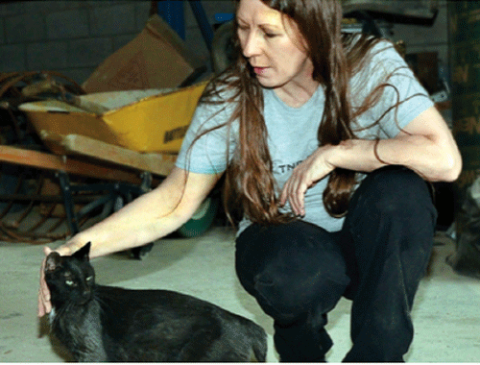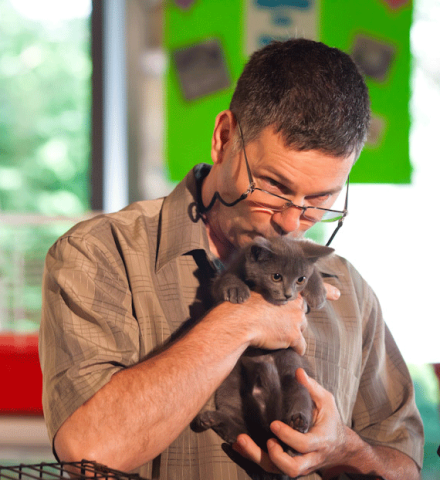
The declaration, to be made this week by Mayor Rob Ford, coincides with International Feral Cat Day on Oct. 16, an annual event started more than a decade ago by U.S.-based Alley Cat Allies which, like rescue groups here, recognizes the need to promote humane feral cat care, particularly the trap-neuter-return (TNR) method of population control.
In Toronto, Feral Cat Awareness Week culminates in what’s expected to be a high-profile adopt-a-thon Oct. 18 from 11 am to 5 pm at Nathan Phillips Square and featuring rescued cats and kittens plus on-site micro-chipping for pet owners and various educational, volunteering and advocacy displays.
“We hope to have a wide variety of cats and kitten available for adoption,” Roxanne St. Germain tells Samaritanmag. She is a director with the Toronto Feral Cat Project and one of three Recovery Centre Task Force Leaders with the Toronto Feral Cat TNR Coalition, which was founded in 2010 with the common goal of addressing the cat over-population crisis and improving the lives of the thousands of cats living homeless in the GTA.
The Coalition’s members include the Toronto Humane Society, City-run Toronto Animal Services, the Ontario SPCA, Toronto Cat Rescue, Annex Cat Rescue, Action Volunteers for Animals, Urban Cat Relief, Toronto Street Cats, Toronto Feral Cat Project and Animal Alliance of Canada.
“Right now, there are literally thousands of cats available for adoption in the various facilities across the GTA,” St. Germain continues, stressing that cats available at the adopt-a-thon, though former strays, are highly social and most likely lost or displaced former pets.

The event at Nathan Philips Square represents a genuine hands-across-the-water moment between the City and the various above-mentioned rescue/advocacy groups who until recently viewed Toronto as euthanasia-happy and having no real interest in pursuing humane and long-term solutions to cat over-population through systemic and free sterilization, according to Councillor Glenn De Baeremaeker (Ward 38 Scarborough Centre).
But as De Baeremaeker — an admitted cat lover and long-time feral advocate — tells Samaritanmag with audible pride, the City and the various rescue groups have gone “from mortal enemies to groups that are totally in love with each other,” with no-kill policies in place at the shelters.
“Previously the people who helped cats the most — these cat rescue volunteers — hated the City, which was insane because we love cats too. The catalyst was in 2009 when I was able to raise $1 million for the Scarborough animal hospital,” De Baeremaeker says, referring to Toronto Animal Services East End which tapped cat rescue and advocacy groups for input.
As for the money, De Baeremaeker says he raised it through a community benefit program which requires condo developers, for example, to “contribute money that goes into a pot.
“The local councillor, in this case me, gets to say what’s needed in the community. And what we desperately needed was an animal hospital. In the three short years since its inception, that hospital has performed something like 11,000 operations on both our shelter animals and on feral cats. It’s been spectacular.

“Three years later, there is a culture of cooperation. Money from the City goes to the Feral Cat Recovery Centre — the first one we think in North America that is an industrial unit housing 40 or 50 recovering cats at a time. That centre is totally operated by volunteers, but the city pays $20,000 of the annual $22,000 rent, the rest is paid by the various rescue groups. That way they have the pride to say, ‘We are also contributing.’”
As the Toronto Feral Cat Project’s Germain notes, raising public awareness about the importance of spay-neuter for cats is imperative, as is compassion for the thousands of cats currently left homeless in biting Canadian winters. Reinforcing the status of cats — that, like dogs, they are not expendable and poorly suited to fending for themselves in the outdoors — is also key to the Coalition’s ultimate goal of stamping out cat homelessness.
De Baeremaeker goes even further. “The City is looking at making spay and neutering mandatory,” he says.
“We are also looking at anti-roaming bylaws, which would mean not letting cats off the owner’s property which could really help with the population explosion numbers — some non-neutered Tom runs around impregnating all the neighbourhood cats before coming home to sleep.
“When I was a kid — I am 52 now so say 40 years ago — it wasn’t uncommon to see dogs running loose in suburban neighbourhoods. Back then dogs were the problem. It’s not accepted now. We need to make the same thing happen with cats, hopefully within the next 10 years. We have a no-kill policy with shelters but they are overrun with cats. We are racing to a better place.”
Adds St. Germain: “The origin of all these feral cats are unsterilized cats that were lost or abandoned. That’s how this started and unfortunately the public isn’t getting the message that (animal advocate and game show host) Bob Barker has been preaching for 30 years — spay and neuter your animal.
“There are a lot of options now in the GTA for spay-neuter, so it’s not acceptable to say, ‘I can’t afford it.’ There are alternatives. And quite frankly if you don’t have the resources to care for a pet, then don’t have a pet. Or get one that is already fixed.”
Sneakers